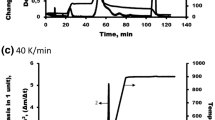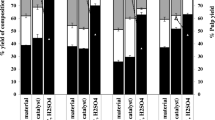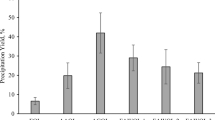Abstract
In this study, the devolatilization behavior of eastern Mediterranean hazelnut, almond, and sunflower residue was studied using a TGA–FTIR laboratory-scale setup. The original biomasses were fractionated using the Van Soest detergent analysis. Both the original and fractionated biomasses were investigated. The reaction temperature was increased to 900 °C using a heating rate of 2 °Cmin−1. The pyrolysis of lignin produced the largest gas production, with CO2 constituting up the bulk of the gas mixture. CO is the second highest-yield gas and is primarily formed from the samples of cellulose and lignin. For the lignin samples, the pyrolysis operation yielded the maximum amount of char, while the combustion of the lignin chars produced the highest amount of gas yields. On the other hand, lignin samples, particularly almond lignin, have the lowest tar production. Due to the high ash content the sunflower stalk sample devolatilized at a lower temperature with respect to the rest of the samples, resulting at a mass loss peak at lower temperature. The hazelnut lignin showed the mass loss peak at the highest temperature. Generally, CO2 showed the highest mass yield, and it was mainly produced from the cellulose and whole biomass samples. Among all samples CH4 was produced in minor quantities and mostly in lignin devolatilization. Furthermore, the devolatilization behavior of the fractionated biopolymers is not enough to sufficiently predict the behavior of the whole biomass sample. The results described in this paper can help further the understanding of thermal processes where almond, hazelnut, and sunflower residues from the eastern Mediterranean region, and their fractionated-derived products are involved.












Similar content being viewed by others
References
O.O. Olantunji, M.P. Akinlabi, M.P. Mashinini, S.O. Fatoba, O.O. Ajayi, Thermo-gravimetric characterization of biomass properties: a review. IOP Conf. Ser. Mater. Sci. Eng. 423, 012175 (2018)
C. Keattch, Studies in the history and development of thermogravimetry. J. Therm. Anal. 44, 1211–1218 (1995)
J. Cai, D. Xu, Z. Dong, X. Yu, Y. Yang, S.W. Banks, A.V. Bridgwater, Processing thermogravimetric analysis data for isoconversional kinetic analysis of lignocellulosic biomass pyrolysis: case study of corn stalk. Renew. Sustain. Energy Rev. 82, 2705–2715 (2018)
S. Wang, G. Dai, H. Yang, Z. Luo, Lignocellulosic biomass pyrolysis mechanism: a state of the art review. Prog. Energy Combust. Sci. 62, 33–86 (2017)
H. Zhou, Y. Long, A. Meng, S. Chen, Q. Li, Y. Zhang, A novel method for kinetic analysis of pyrolysis of hemicellulose, cellulose and lignin in TGA and macro-TGA. RCS Adv. 5, 26509 (2015)
V. Volli, R. Varma, D. Pradhan, A.K. Panda, C.M. Shu, Thermal degradation behaviour, kinetics, and thermodynamics of Bombax Malabarica seeds through TG–FTIR and Py-GC/MS analysis. Sustain. Energy Technol. Assess. 57, 103150 (2023)
P. Zong, Y. Jiang, Y. Tian, J. Li, M. Yuan, Y. Ji, M. Chen, D. Li, Y. Qiao, Pyrolysis behavior and product distributions of biomass six group components: starch, cellulose, hemicellulose, lignin, protein and oil. Energy Convers. Manage. 216, 11277 (2020)
X. Ming, F. Xu, Y. Jiang, P. Zong, B. Wang, J. Li, Y. Qiao, Y. Tian, Thermal degradation of food waste by TG–FTIR and Py-GC/MS: pyrolysis behaviors, products, kinetic and thermodynamic analysis. J Cleaner Prod. 244, 118713 (2020)
Q.V. Bach, W.-H. Chen, A comprehensive study on pyrolysis kinetics of microalgal biomass. Energy Convers. Manage. 131, 109–116 (2017)
N. Liu, J. Li, J. Liu, K. Xu, F. Ren, X. Yao, Study on pyrolysis behavior of agricultural and forestry wastes using thermogravimetric-Fourier transform infrared spectrometer (TG-FTIR). AsiaPacific J. Chem. Eng. (2023). https://doi.org/10.1002/apj.3020
L. Zhang, Z. Yang, S. Li, X. Wang, R. Lin, Comparative study on the two-step pyrolysis of different lignocellulosic biomass: Effects of components. J. Anal. Appl. Pyrol. 152, 104966 (2020)
F. Xu, X. Zhang, F. Zhang, L. Jiang, Z. Zhao, H. Li, TG–FTIR for kinetic evaluation and evolved gas analysis of cellulose with different structures. Fuel 268, 117365 (2020)
M. Zhang, F.L.P. Resende, A. Moutsoglou, D.E. Raynie, Pyrolysis of Lignin extracted from prairie cordgrass, aspen, and Kraft lignin by Py-GC/MS and TGA/FTIR. J. Anal. Pyrol. 98, 65–71 (2012)
C.G. Yoo, Pretreatment and fractionation of lignocellulosic biomass for production of biofuel and value-added products. PhD thesis, Iowa State University (2012)
X. Zhao, K. Cheng, D. Liu, Organosolv pretreatment of lignocellulosic biomass for enzymatic hydrolysis. Appl. Microbiol. Biotechnol. 82, 815–827 (2009)
M. Brebu, G. Cazacu, O. Chirila, Pyrolysis of lignin-a potential method for obtaining chemicals and /or fuels. Cellul. Chem. Technol. 45, 43–50 (2011)
S. Wang, Q. Liu, Z. Luo, L. Wen, K. Cen, Mechanism study on cellulose pyrolysis using thermogravimetric analysis coupled with infrared spectroscopy. Front. Energy Power Eng. China 1, 413–419 (2007)
J.H. Lora, W.G. Glasser, Recent industrial applications of lignin: a sustainable alternative to nonrenewable materials. J. Polym. Environ. 10, 39–48 (2002)
R.J.A. Gosselink, E. de Jong, B. Guran, A. Abaecherli, Co-ordination network for lignin-standardization, production and applications adapted to market requirements (EUROLIGNIN). Ind. Crops Prod. 20, 121–129 (2004)
H.V. Scheller, P. Ulvskov, Hemicelluloses. Ann. Rev. Plant Biol. 61, 263–289 (2010)
P.J. Van Soest, J.B. Robertson, B.A. Lewis, Methods for dietary fiber, neutral detergent fiber, and nonstarch polysaccharides in relation to animal nutrition. J. Dairy Sci. 74, 3583–3597 (1991)
L. Ballice, M. Sert, M. Sağlam, M. Yüksel, Determination of pyrolysis kinetics of cellulose and lignin fractions from selected Turkish Biomasses. Arabian J. Sci. Eng. 45, 7429–7444 (2020)
N. Worasuwannarak, T. Sonobe, W. Tanthapanichakoon, Pyrolysis behaviors of rice straw, rice husk, and corncob by TG-MS technique. J. Anal. Appl. Pyrol. 78, 265–271 (2007)
Q. Liu, S. Wang, Y. Zheng, Z. Luo, K. Cen, Mechanism study of wood lignin pyrolysis by using TG–FTIR analysis. J. Anal. Appl. Pyrol. 82, 170–177 (2008)
S. Wang, K. Wang, Q. Liu, Y. Gu, Z. Luo, K. Cen, T. Fransson, Comparison of the pyrolysis behavior of lignins from different tree species. Biotechnol. Adv. 27, 562–567 (2008). (Bioenergy Research & Development in China ICBT)
B. Li, W. Lv, Q. Zhang, T. Wang, L. Ma, Pyrolysis and catalytic pyrolysis of industrial lignins by TG-FTIR: kinetics and products. J. Anal. Appl. Pyrol. 108, 295–300 (2014)
H. Yang, R. Yan, H. Chen, D.H. Lee, C. Zheng, Characteristics of hemicellulose, cellulose and lignin pyrolysis. Fuel 86, 1781–1788 (2007)
G. Varhegyi, M.J. Antal, T. Szekely, F. Till, E. Jakab, Simultaneous thermogravimetric-mass spectrometric studies of the thermal decomposition of biopolymers. 1. Avicel cellulose in the presence and absence of catalysts. Energy Fuels 2, 267–327 (1988)
J.G. Reynolds, A.K. Burnham, Pyrolysis decomposition kinetics of cellulose-based materials by constant heating rate micropyrolysis. Energy Fuels 11, 88–97 (1997)
A. Jensen, K. Dam-Johansen, M.A. Wójtowicz, M.A. Serio, TG–FTIR study of the influence of potassium chloride on wheat straw pyrolysis. Energy Fuels 12, 929–938 (1998)
B. Joffres, D. Laurenti, N. Charon, A. Daudin, A. Quignard, C. Geantet, Thermochemical conversion of lignin for fuels and chemicals: a review. Oil Gas Sci. Technol. Rev. D’IFP Energ. Nouv. 68, 753–763 (2013)
O. Faix, E. Jakab, F. Till, T. Szekely, Study on low mass thermal degradation products of milled wood lignins by thermogravimetry–mass-spectrometry. Wood Sci. Technol. 22, 323–334 (1988)
Acknowledgements
The authors gratefully appreciate the financial support of The Scientific and Technological Research Council of Turkey (TÜBİTAK) (Project No: 106T748) and thank the Council of Higher Education (Turkey) for the scholarship. The authors appreciate the Karlsruhe Institute of Technology for analyzing the elemental composition of the biomass samples. The authors also appreciate the TU Delft/Faculty of 3 mE, Department of Process and Energy for the TGA–FTIR analysis of the biomass samples. Finally, the authors would like to thank Prof. Dr. M. Yüksel, Prof. Dr. M. Sağlam, and Mr. G. Serin for their support in the isolation steps of the biomass samples.
Funding
The Scientific and Technological Research Council of Turkey, Council of Higher Education (Turkey), Karlsruhe Institute of Technology, TU Delft/Faculty of 3 mE, Department of Process and Energy.
Author information
Authors and Affiliations
Corresponding author
Additional information
Publisher's Note
Springer Nature remains neutral with regard to jurisdictional claims in published maps and institutional affiliations.
Rights and permissions
Springer Nature or its licensor (e.g. a society or other partner) holds exclusive rights to this article under a publishing agreement with the author(s) or other rightsholder(s); author self-archiving of the accepted manuscript version of this article is solely governed by the terms of such publishing agreement and applicable law.
About this article
Cite this article
Ballice, L. Investigating the Pyrolysis Properties of Cellulose and Lignin Isolated from Different Turkish Biomass Using TG-FTIR. Korean J. Chem. Eng. 41, 2367–2376 (2024). https://doi.org/10.1007/s11814-024-00189-z
Received:
Revised:
Accepted:
Published:
Issue Date:
DOI: https://doi.org/10.1007/s11814-024-00189-z




